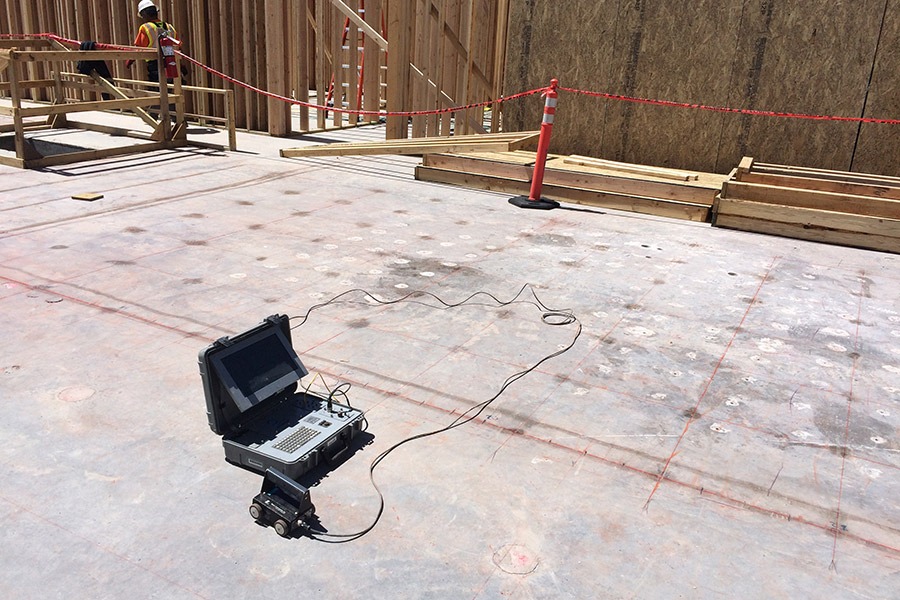Impact Echo Scanning
Impact Echo Scanning (IES) investigations are performed on large structural members with smooth concrete where shallow voids, honeycomb, cracking or delaminations are of primary concern.
The Impact Echo Scanning (IES) system is designed for large area investigations of shallow voids, debonding/delamination, cracking, or honeycomb often found between an overlay on a bridge deck or surrounding dense rebar mats. IES is commonly used to evaluate post-tensioning (PT) cables used in reinforcing various structures and determining duct grout condition. The scanning technology allows tracing of ungrouted PT cables through slabs and beams. An advantage of the IES method is that only one side of the structure needs to be accessible for testing.
The IES Method is based on the Olson Engineering patented technology of a rolling transducer and automated impactor for near-continuous Impact Echo based thickness and flaw scanning of structural concrete and pavements. Performed at slow walking speeds, test results are obtained every inch (25 mm) in a line and multiple lines can be combined for 2-D to 3-D displays of concrete thickness and locations of internal void, honeycomb, cracking, delamination, etc. The scanning method is capable of determining bottom echo thicknesses up to ~ 24inches (0.6 m).
Data Platform Required, Sold Separately
 |
Freedom Data PC |
 |
NDE 360 |
Impact Echo Case Studies
Applicable On:
- Beams
- Bridge Decks
- Columns
- Dams
- Pavements
- Pipes
- Post-Tensioned Ducts
- Runways
- Slabs
- Tunnels
- Walls
Test For:
- Cracks
- Delaminations
- Honeycomb
- Thickness
- Voids
Meets ASTM:
- ASTM C1383-04
Meets ACI:
- N/A
Key Features & Specifications
| Thickness accuracy ± 2% at high resolution when calibrated on a known thickness |
No coupling agents required for use of test head on concrete |
| Thousands of tests can be performed per hour when “imaging” of internal concrete conditions is required | Works on cured, hardened concrete in air or on grade |
| System is compact, durable, and easily transported allowing for multiple tests per day |
Works through paint and most types of bonded tile |
| Real-time waveform display while testing | Easy velocity calibration at known thickness |
| Software allows for more sophisticated processing | Thickness maps are easily constructed from data |
| English or Metric units can be used |
IES SYSTEM (BASE MODEL)
| Description: | Test For: | Applicable On: |
| The IES Model can be operated from either the Freedom Data PC or the NDE 360, sold separately. Allows for rapid IE testing of large areas.
There are minor differences between operating this system with the Freedom Data PC vs. the NDE 360. The Freedom Data PC provides faster and more extensive processing capability and additional data storage space. The field-friendly NDE 360 is compact and lightweight. The IES data can be downloaded from the NDE 360 to a PC, allowing for the same post processing available with the Freedom Data PC. |
|
|
Hands-on training is available for all of our NDE test methods at our Wheat Ridge, Colorado (USA) location, which is a suburb located approximately 15 minutes northwest of downtown Denver. Training may be available at your location by one of our agents/engineers upon special arrangement.





